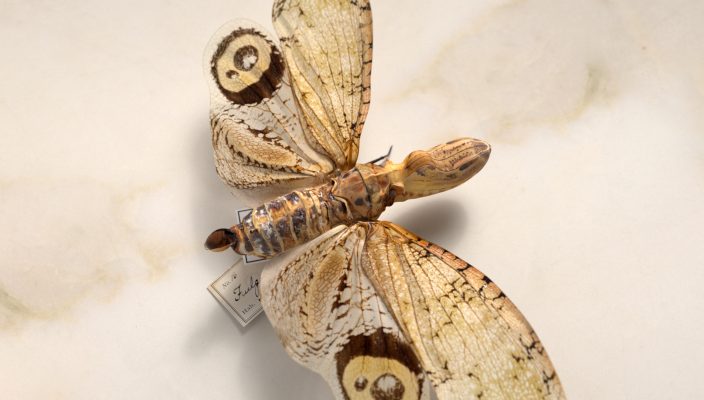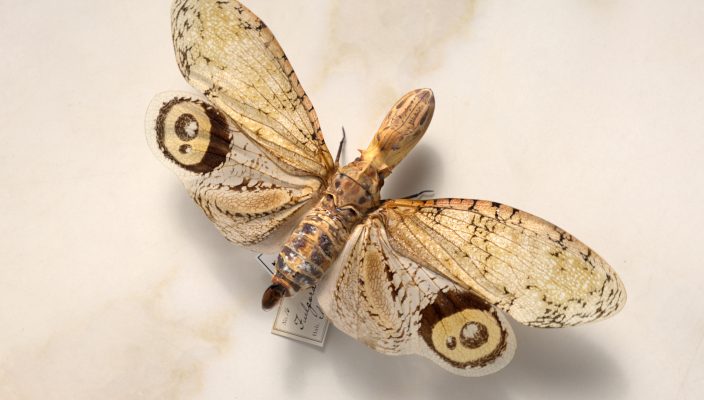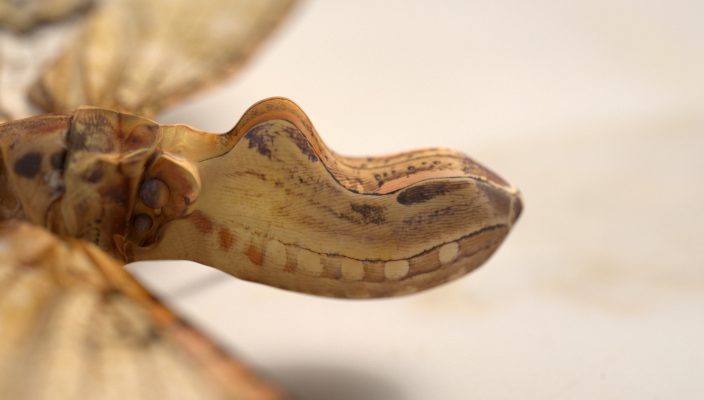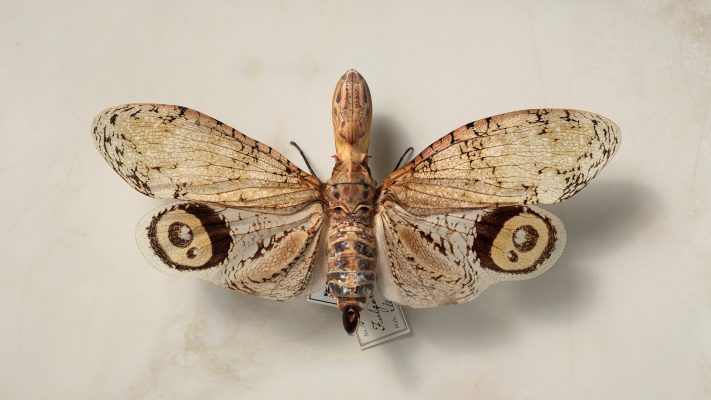Here I offer some reflections and several facts potentially useful for a phenomenology of the mask. Needless to say, these hypotheses are of an adventurous character. With them I offer nothing less than an origin to the universal use of the mask by people, which goes back beyond this species, to the insects who still wear it.
1
The Importance of the Mask
All humanity wears or has worn a mask. This enigmatic accessory without useful end is more widespread than the lever, the bow, the harpoon or the plough. Some peoples were entirely ignorant of more humble, or more precious tools. Yet, they knew of the mask. Some civilisations, among them the most remarkable, have prospered without having the idea of the wheel, or, worse, without knowing how to use it. Yet they were familiar with the mask. Man in general, abstract and hypothetical man, from the first eras and the first cultures – could not have embodied more accurately, more appropriately, Descartes’s saying: ‘I advance masked.’ There is not a tool, an invention, a belief, a custom, or an institution which brings about the unity of humanity to the same degree accomplished by the wearing of the mask.
The Mask remains mysterious. What are the reasons that have driven people to cover their faces with a second visage, instrument of metamorphosis and ecstasy, of possession by the gods – instrument, as well, of intimidation and of political power? All of ethnology is filled with masks, and with the vertigo, the trances, the hypnoses, and the panics that are its nearly inevitable consequences. Here I chance my first sprawling hypothesis: a people enters history and civilisation the moment they reject the mask, when they repudiate it as an instrument of individual or collective panic, once they consign it to an institutional function. Even reduced to a simple carnival accessory or mundane festivity, it disquiets and fascinates. Its power of seduction has been completely appropriated, yet it does not disappear. I will come back to this. For the moment, though, I would like only to underline that the problem of the mask is neither episodic, nor local. It affects the entire species.
2
People and Insects
Here I come to a second wild hypothesis: the family resemblance between insects and people. For a while now I have tried to demonstrate how the behaviour of the one corresponds to the mythologies of the other. I brought conduct and fiction, instinct and phantasm, face to face.
There is more to it though: the problem of a society that leads to castes, war, colonisation and slavery; the problem of language and that of geometry (for bees); that of drugs and of voluntary intoxication, death drives, and ‘vices’ (for ants). Always – with the same opposition between automatism and liberty, between fixity, immutable repetition, and invention – the fluidity of history. On one side, the inscription of the body, valid for thousands of centuries, and, beyond that, the perfection of the organ, the antennae, the pupae, the facetted eyes, without even mentioning the quasi-somnambulistic infallibility of instinct. On the other side, the capacity to create crude and clumsy tools (external), insufficient weapons (external), and cumbersome clothing, which, unlike carapaces and fleeces, does not form part of the body like the armours or fur-coats that cannot be taken off. Then come machines for fabricating clothes, weapons, or tools; followed by complex machines for fabricating the more simple machines. This faculty, capable of developing itself without end, implies the blind search for error and the rectification of error. It inaugurates, at the same time, decisive freedom. It pre-supposes an imprecise and ambiguous language that encourages non-sense, not a system of unequivocal signals, with its limited code of swarming, and inexorable choreographies that people wrongly call the language of bees, due to a radical misrecognition of the confused nature of language, and the unquestionable practical similarities. This sinister or happy fall from grace has as its precondition, still, class conflict in society, religious wars with hate and fanaticism – revindications, revolts and revolutions – not an inalterable order, not a perfect economy and physiology corroborating or dictating the social regime. It supports mathematical speculations which invent hyper-spaces, abstract volumes – unimaginable, if not inconceivable, amusements in the refined, free play of arbitrary signs – not the implacable and exclusively hexagonal geometry of the honeycomb.
I stop myself here, but the analogies abound. They follow any customary contrast, even the strict parallelism of a term for term opposition: the insect created in itself, thus at the level of the species; man outside of himself, thus at the level of the individual.
3
Fulgora Laternaria
Certain insects, such as the Cyphonia, the Heterontus, and the Sphongophorus, grow giant shades above them like torturous umbrellas, superstructures in disconcerting forms. These branching, encumbering appendages have no apparent utility. They are purely ornamental, airy excrescences, which bifurcate spontaneously, in a granular and absurd fashion, completely in the service of equilibrium and symmetry. They cannot but recall the angular and skilfully corrected cross-outs in Rabindranath Tagore’s manuscripts, the indentations in the most exceptionally crafted mediaeval keys, or the zigzagging sinuosities of Scythian animal art. More than anything they resemble the scaffolding mounted atop certain Oceanic and American ceremonial masks.
Additionally, very large scarabs grow certain pointy appendages, which is why some of them have been named after the rhinoceros or the nasicorn. The lucane lumbers along with a big articulated deer antler, which would function like a jaw, except it has no function. Similarly the sorcerer’s masks are frequently adorned with horns and antlers. I will raise no argument against it.
There is a type of Hemiptera named fulgoras that the dictionary timorously defines as ‘luminous insects from hot countries.’ The naturalists make a distinction between (or rather would have distinguished in the year X [of the French Revolution] since classifications are ephemeral): the lantern-holder fulgora (from Brazil and from Guyana); the candle-holder fulgora (from China); the tenebrous fulgora (from Guinea); the phosphorescent fulgora and the nyctalopic fulgora (from Surinam); the gleaming fulgora (from Cayenne); and, finally, the European fulgora (from Mediterranean Italy and from Sicily). With the exception of the last one, which is strictly geographic, each of these adjectives allude to the presumed relation between these insects and light. This conclusion is arrived at through a deeply rooted belief about the dominant fulgora, the Fulgora laternaria, or lantern fly. In the eighteenth century Maria Sibylla Merian attributed to it the legend of radiating such a considerable light that she could read a newspaper by their brightness. The head of this variety of fulgora extends before it as an empty protuberance nearly as voluminous as its body. You can imagine that the insect got its name from a lantern, yet we have to get over it, because the fulgora is not luminous. It’s the emptiness in the protuberance that creates doubts: the lantern lacks a candle. Such naiveté is no longer accepted. However, some scientists would concede that the protuberance has a faint luminosity: it glows with infra-red rays produced by photogenic bacteria.
In any case, there was no question of the intense light which, according to Maria Sibylla Merian, allowed her easily to read ‘a book similar in typeface to that of the Gazette d’Hollande.’ An art critic, a perspicuous one in my opinion, has remarked that Mona Lisa’s enigmatic smile does not come from the rendering of her lips, but the fact that she was painted perfectly depilated, without lashes or eyebrows. By a sort of transference it’s the smile that attracts attention. I believe that this observation is applicable quite generally. When something surprises us we are led to discover the cause not in the true reason, which we close our eyes to, but in a trait that preconception has designated in advance, or that – for all sorts of reasons – we are expected to notice. The bizarreness of the fulgora is not its presumed phosphorescence. Shocked by the fulgora, I suppose that Maria Sibylla Merian spontaneously attributed to it the surprising feature of lightning bugs.
The cephalic protuberance of the fulgora portrays the head of an alligator with perfect precision. On it a false jaw is drawn and an enormous arc protects the semblance of a globular eye. Behind this simultaneously dwarfish and giant face – on which each of the traits have been perfectly modelled, but nearly caricatured – one discovers with great effort two shining black, almost microscopic, dots: the eyes. The hollow pocket is superfluous. One should not even think of it as a form of mimicry. A Hemiptera that lives on trees, flying from branch to branch, decked out with the head of a centimetre-and-a-half long reptile? To frighten whom? What enemy of the fulgora could be frightened by a real crocodile and at the same time fear its miniaturisation to such a small scale? Nothing is more absurd.
Outside of this, the fulgora truly is a mimetic insect. Its upper wings are covered with camouflage drawn and tinted so as to allow them to blend with the trunk of the Simarouba tree, which this insect takes to by preference. From their abdomen large waxy fleeces emerge rendering them invisible among the mosses, lichens, and irregularities of the bark. If they take such care to dissimulate, why, at the same time, attract attention with a monstrous mask?
I anticipate two responses to this question. The first consists of denying that the frontal protuberance of the fulgora truly resembles the head of a crocodile: the complacency of the human imagination would thus have brought about a simple illusion. Some details, without a doubt strange, would have encouraged the mania of interpretation, but their purely fortuitous coming-together here – objectively – would represent nothing. But now I bring everyone’s attention back to the photograph of the fulgora. It seems to me that anthropomorphism does in fact play a considerable role. The elements of the resemblance are as such only by virtue of their reciprocal distribution. Isolated, or differently arranged, someone would only be fantasising, recognising eyes or teeth there, the way we amuse ourselves discovering forms in clouds. But, in this particular case, everything fits and comes together like the pieces of a puzzle. I agree that the resemblance is scandalous, but I can no longer, just to avoid a scandal, deny the evidence.
I arrive at the second response. Resting under the dissimulation of the mimetic wings, large ocelli round out the lower wings of the fulgora. Now we know what purpose the ocelli of the sphinx moth and of the caterpillar serve: to stupefy their prey or adversary. The insect unmasks them as its body vibrates convulsively.
Certain insects display circles, simulacra of enormous eyes. They use them to fascinate their eventual predator or victim because imposed and prolonged contemplation of a fixed circle provokes paralysis and hypnosis. This display used by the weak to overpower the strong, or of the slow to immobilise the quick, is accompanied by a frenzy, the rhythm of which possesses a spellbinding power. People and animals are equally susceptible to these purely optical and rhythmic effects.
On one side there are insects whose dissimulating upper wings blend them with their surroundings, who then, in a spasmodic tremor, suddenly reveal enormous circles, the lifelike colours of which stand-in for a sort of absence, or, at least, a neutral presence, difficult to discern. On the other side: masked people, who no longer appear as people, creeping up and conducting themselves as ferocious animals or demons – spectres emerging from another world. They feel possessed by strange and sovereign forces. Their gestures and their cries are dictated by the being who possesses them or whom they incarnate. Thus transformed they terrify and haunt the duped people who cannot identify them and who lose all power to defend themselves and to react. In their panic, they are not capable of recognising the obvious truth: the presence of the person behind the Apparition.
If not for the ocelli, I would doubtlessly hesitate and I myself could adhere to the thesis, unsatisfying as it is, of a caprice of human nature. But the perfectly judicious use of the ocelli is there as well. There is the faux and the implementation of the faux. The insect behaves like a person, wearing a mask and knowing how to use it.
From this point on I have decided no longer to believe in chance and convergence. I distance myself from the scientists to whom these ocelli and other astonishing anomalies appear as simple ornaments. As I can see this word only constitutes a weak metaphor compared to that of the mask, which I adopt here by preference. Once again, it’s necessary to restate the opposition between the world of insects and that of people: the immobile ‘mask,’ sculpted forever in the morphology of the species, and the fragile simulacrum, exterior and mobile, with which the officiant covers his face in the act of deception. But the intended effect is the same and the means of obtaining it symmetrical.
The protuberance of the fulgora is a mask. From this point on it is less important that it portrays or does not portray an alligator’s head. A mask is not made to faithfully represent another face. It is not destined to bring change but to terrify. I would like to see entomologists research the mask of the fulgora, to know if it really is terrifying, if it truly frightens the animals it would be in the interest of the fulgora to frighten; put differently: if this insect makes use of its mask to complete the effect of its ocelli.
4
Reasons Behind the Mask’s Destitution
Humankind has relinquished its claim on the mask. The sacrifice is considerable when we recall that the mask remained for a long time the sign of superiority, par excellence. In primitive societies it was always a question of whether to be masked (and to inspire fear) or not to be (and to feel fear) – or, in a more complex organisation – to fear a few and to inspire fear in others, according to the degree of initiation. To be instructed in the mystery of a more secret mask is to pass on to a higher level. But this means learning that the frightening, supernatural apparition is but a man disguised, a man who masks himself to terrify the unholy or those initiated at a lower level.
The decline of the mask is certainly a problem worth considering. How and for what reason has humankind been led to renounce it? The question does not appear to have concerned ethnographers. As such, it is of extreme importance. I advance the following hypothesis which excludes nothing – on the contrary it calls on the existence of multiple, diverse, and incompatible strains of thought, corresponding to each culture and particular situation, and, as such, it proposes a mechanism common to each. The mask’s system of initiation only functions if there is a constant overlap between the revelation of the secret of the mask and, in turn, the right to use it to terrify the uninitiated and to access the divinatory trance. In this way knowledge and use are directly linked. Only one who knows the true nature of the mask and of the masked can put on appearances convincingly. Above all, it is impossible to submit oneself to a leader – or at least to submit oneself to the same degree, with the same feeling of sacred panic – if one knows that he is simply wearing a disguise. This is practically impossible to ignore, or, in any case, to ignore for a long time. At this point a permanent fissure emerges in the system, which must defend itself against the curiosity of the uninitiated by a complete series of prohibitions and punishments – those latter being the most real. In fact, only death is effective against a kept secret. Because of this the mechanism, in spite of seeming to prove itself by bringing about ecstasy and possession, remains fragile. At all times it must defend itself against accidental discovery, indiscrete questions, hypotheses, or explanations. Inevitably the fabrication of masks and the wearing of disguises, without losing their sacred character as such, could not preserve themselves through the threat of death forever. By unnoticed transformations they become mere liturgical ornaments, ceremonial accessories for dance or theatre.
5
The Ultimate Fascination
Perhaps the most recent attempt at political domination by the mask was that of Hakim Al-Muqanna, the Veiled Prophet of Khorassan, who, during the final years of the eighth century (from 160 to 163 of the Hegira), held the armies of Caliph in check. Over his face he wore a green mask, (according to some it was made of gold) which he never removed. He claimed to be God, stating that he covered his face because no mortal could behold him without going blind.
His adversaries violently contested his pretensions, with good reason. The chroniclers – it is true, all the historiographers of the Caliph – write that he acted in this way because he was bald, one-eyed, and repulsively ugly. His disciples summoned him to prove that what he claimed was true, insisting upon seeing his face. When some of them were actually burned when he revealed it to them, the others were convinced. The official history explains the miracle, uncovering (or inventing) the stratagem. Here is the account of the episode, as it is found in one of the oldest sources, Description topographique et historique de Boukhara par Abou-Bak Mohammad ibn Dja’ far Narshkakhi, completed in 332.
Fifty thousand of Al-Muqanna’s soldiers protested at the door of the castle demanding to see him. They implored and insisted, saying they would not budge until they saw the face of their god. Al-Muqanna had a servant called Hadjeb to whom he said: ‘go tell my creatures Moses asked to let him see my face but I did not agree to show him because he would not have been able to bear my gaze – and if someone were to see me he would die instantly…’ But the soldiers continued to implore him. Al-Muqanna then told them: return on the appointed day and I will show you my face.’
‘Then, to the one hundred women whom he kept with him in the castle in addition to his servant Hadjeb (and these were largely the daughters of peasants from Soghd, Kesh, and Nakshab) he gave the order to take a mirror up to the roof of the castle. He showed them how to hold the mirrors in such a manner that when one faced the other the surfaces all reflected the most intense sunlight. At this point the men had gathered again. When the sun reflected upon the mirrors the area, and all of its surroundings, were submerged in this light. He then said to his servant: ‘Say to my creatures: here is your god presenting himself to you. Behold him! Behold him!’ The men were terrified. They prostrated themselves.’
Following this, Al-Muqanna supported his divinity with additional illusions: out of a pit in Nakshap he erected a luminous entity resembling a moon, the light of which shined for several miles during a period of two months. One text even describes this entity returning into the pit after having risen to a certain height. However, the ancient chroniclers remain mute on the mechanics of this miracle and on the nature of its luminous globe, which was perhaps an ancestor, modest and distant, of future hot air balloons.
Al-Muqanna justified his divine nature and his human superiority with this unsubtle theology: ‘God was himself incarnated several times in the form of the prophets and each prophet was superior to those who preceded him. The preceding incarnation was effectuated in the form of d’Abu Moslim, who thus came to be considered superior to the other prophets. He himself constituted the most recent incarnation of the divinity.’ The Caliph had only to surrender.
But the incredulous (or impious) Caliph sent armies against Al-Muqanna all the same. To recruit the greatest number of followers, he constructed a theology with a seductive ethic of his own: ‘he gave permission to the adherents of his sect to kill those who did not share their beliefs, to take their women and children into captivity, to regard their belongings as fair game. He accorded them an absolute liberty in sexual relations, considered as licit all the acts declared illicit by the Muslim religion and advised them to take no account of religious prescription or prohibition.’
Victory would change camp multiple times, but, in the end, Bagdad was conquered. In 163 of the Hegira, Al-Muqanna was confined to his castle. To traverse its moats the attacking army had brought with them two thousand buffalo hides from India. The Prophet’s generals defected. Seeing he had lost, Al-Muqanna employed an artifice that would assure his posthumous prestige by making his followers believe that he had ascended directly to the heavens. In the language of Narshaki, who is said to take his account from Mohammad ibn Daafar (the illustrious Abou Djafar Mohammad ben Djarir ben Yesid Tabari), who takes his own account from Abou Ali Mohammad ibn Haroun, cultivator of Kesh:
‘My grandmother was among the women that Muqanna had engaged and kept with him in the castle. She recounted that one day Muqanna invited all the women to drink at his table, as he had the habit of doing. But, on this day, he put poison in the wine destined for the women. He had prepared a personal cup for each woman. He said to them: ‘By the time I drink from my cup you will have to have drunk yours entirely.’ Then all the women emptied their cups, save for me who had kept the wine in my throat. And so all the women died and I laid down next to them, pretending to be dead too. Muqanna did not notice. He got up, looked around and, finding all the women dead, approached his personal servant and killed him by severing his head from his body.
He had already ordered the oven be kept lit three days prior. He approached the oven, undressed, and threw himself in. Smoke emanated from the oven. I approached, but I found no trace of Muqanna. There was no one in the castle…’
The chroniclers differ a little in their manner of recounting this ending. According to one Al-Muqanna threw himself into a pit of quicklime; according to another it was a vat of vitriol; according to a third (Awfi) it was a cauldron of mercury; and according to others still, it was a copper foundry, or a vat of tar or sugar. Barthélemy d’Herbelot de Molainville relates the episode in the following manner:
‘Seeing in the end he had no choice but to surrender or perish, he resolved to poison everyone in his circle. One of his concubines who discovered his plan hid herself in a corner of the castle to escape this danger and saw that, after everyone’s death, Al-Muqanna took their bodies and burned them, after which he threw himself into a vat full of nitric acid that he had prepared. They found nothing of his body but his hair, which remained floating on the water.’
The subterfuge succeeded. The prophet’s followers were persuaded that their master had ascended into the sky for a time, and would redescend to earth once more. Khorassan did not see peace again for a long time. This only kept the annalists from denouncing Hakim’s fraud unanimously. Later, the Reign of the Mask appeared as that of an imposture and jester. Long after being conquered it continues to act upon the imagination.
*
I have not mentioned when and to whom the story of Al-Muqanna was known in the occident. In 1697, Herbelot included it in the entry that he dedicated to the prophet in his encyclopaedia, but it is possible that other orientalists had made allusions to it elsewhere. The work was reedited in 1777, with some additions by Galland. In 1787, in Ajaccio, a 17-year-old Napoléon Bonaparte wrote a short biography of Al-Muqanna. He titled it Le Masque Prophète [The Masked Prophet]. It was his first literary essay. Published in 1821, it seems that some pages had been taken for a work of imagination. They ended – quite prophetically – with the following reflection: ‘This example is incredible. How far the mania of illustration can be pushed!’ The author would show this in practice.
In 1914, in the Psychologische Abhandlungen, published in Vienna by C. G. Jung, J. Votoz has deduced from this supposed tale the character and destiny of Napoleon. I cannot procure this monograph, about which a phrase by Kuhn, in his work Le Masque, warrants my conjecture.
Jorge Luis Borges has devoted a short chapter to Al-Muqanna in his Historia Universal de la Infamía. This is an entirely original work as the cited sources are not known to the author, who, in return utilises none of those known to Sadighi and the other Iranists. At the same time, the events of the life of Al-Muqanna found in his essay are peculiar to Borges, who leaves out to the contrary the three episodes well accounted for by the chroniclers: the burning mirrors, the artificial moon, and the suicide in the oven. The Historia Universal de la Infamía includes a bibliography by subject. For Hakim, only two works are mentioned: the enigmatic and inaccessible Vernichtung der Rose and the vast, summary, and very accessible History of Persia by Sir Percy Sykes. However this last work only dedicates a dozen or so lines to the Veiled Prophet, in which the only point in common with the biography composed by J. L. Borges remains the allusion to the poem by Moore.
6
The Cycle is Closed
In France around 1700 the mask is a courtly diversion. But simple happenstance suddenly demonstrated the permanence of the anguish it provokes. It took place in such an unexpected fashion that the description of Saint Simon, the realist, takes on a fantastical tone such as one finds in Hoffman or Edgar Allan Poe.
‘Lieutenant General Bouligneux and Field Marshal Wartigny were killed at the Siege of Verue; two totally singular men of great valour. The previous winter we had made several very naturalistic wax masks of the court, which we wore under other masks so that, in unmasking, people were tricked into mistaking the second mask for a face, while the true one, completely different, was below. We heartily amused ourselves with this game. This winter, we wanted to entertain ourselves with this again. To our great surprise we found each of the masks arranged as we had left them after the carnival, fresh and natural, except those of Bouligneux and of Wartigny, which, conserving their perfect resemblance, had the pallor and the dignity of those who have just died. They made an appearance at the ball and inspired such horror that we tried to touch them up with rouge, but the rouge wore off instantly so the impression could not be altered. It was so extraordinary to me that I felt the need to recount it; I would have kept it secret too, if only the entire court had not been, like me, a witness, extremely surprised, and several times over, by this strange singularity. In the end we threw out the two masks.’
During the same period, in Venice, the mask was accessory to amorous intrigue and political conspiracy. Etiquette and institutions governed it. Yet it became a semi-official resource, as described in the collection by Giovanni Comisso, Les Agents secrets de Venise au XVIIIe siècle.
‘The bautta was a kind of short-cloak added to a black cap and mask. The origin of this name is the cry: bau, bau, with which one inspires fear in children. Everyone wore it in Venice, starting with the Doge when he wanted to come and go freely in the city. It was worn by the nobles, both men and women, to keep them at a luxurious distance from the public, to protect what the patrician class believed was their dignity. The doormen of theatres ensured that the nobles wore a bautta over their face, but once inside the hall, they kept them on or took them off according to their own pleasure. When the patricians came to confer with ambassadors about affairs of the State they came wearing the bautta, requiring the ambassadors on such occasions to do so as well.
***
Soon all that remained were the wolves of masked balls and the cardboard heads of carnivals. In 1900, Jean Lorrain spoke once more of the mask with sensibility. In 1948, Georges Buraud spoke of it with science and nostalgia. The cycle is closed.
Appendix
Napoleon Bonaparte: The Mask of the Prophet
In the year 160 of the Hegira, Mikadi ruled Bagdad. This grand, generous, enlightened, and magnanimous prince saw the Arab empire prosper in the bosom of peace. Feared and respected by his neighbours, he understood the task of making the sciences flourish and accelerating progress. Yet the tranquillity was troubled by Hakem Al-Muqanna, who, deep in the land of Korassan, began to divide the parties comprising the empire into sectarians. Hakem, of a high stature, masculine and convincing, called himself the envoy of God. He preached a strict morality that pleased the multitude; the equality of rank and fortune were the regular content of his sermons. The people fell in line with his teachings. Hakem had an army.
The Caliph and his elders felt it necessary to snuff out such a dangerous insurrection at its very beginning; but their troops were beaten several times, and Hakem attained greater superiority each day.
A cruel illness, brought about by battle fatigue, took its toll on the face of the prophet. He was no longer the most handsome of all Arabs. His noble and severe traits, his eyes, big and full of fire, were disfigured; Hakem became blind. This transformation could have lessened the enthusiasm of his adherents. But he had the idea of wearing a silver mask.
He appeared before his followers; Hakem had lost nothing of his eloquence. His speech had the same force; he spoke to them and convinced them that he only wore the mask to keep men from being blinded by the light emanating from his face.
Now more than ever he placed his hopes in the delirium of the people that had exalted him, when the loss of a battle had ruined his affairs, diminished his followers and weakened their faith; he was besieged in one of his few remaining garrisons. Hakem had to die or his enemies would come to take hold of his body! He assembled all of his followers and said to them: Faithful ones, we who God and Mohamed have chosen to restore the empire and reclaim our nature, why should the number of our enemies discourage us? Listen: last night, as you were deep in sleep, I bowed and prayed to God: ‘My father, you have protected me for so many years’ – what could my followers or I have done to offend you so that you abandon us?’ A moment later, I heard a voice say to me: ‘Hakem, those alone who have not abandoned you are your true friends, and they alone are the chosen ones. They will share with you in the riches of your illustrious enemies. Wait for the new moon, dig large pits and, precipitously, your enemies will go there, like flies, distracted by the smoke.’ The pits were soon dug, and they filled them with coal, and placed vats filled with alcohol around the edges.
All that finished, they took a meal in common, drinking the same wine, and all died with the same symptoms. Hakem dragged their bodies into the coal, which consumed them, brought the fire up to the alcohol and threw himself in. The next day, Caliph’s troops advanced but stopped upon seeing all of the doors open. They entered with caution but they only found a woman, Hakem’s mistress, who had survived him. Such was the end of Hakem, whose followers believed had been taken up to heaven along with his faithful.
This example is incredible. How far the mania of illustration can be pushed!
share
ABOUT THE CONTRIBUTOR
Roger Caillois
(1913–1978) was a French intellectual whose idiosyncratic work brought together literary criticism, sociology, and philosophy by focusing on diverse subjects such as games, play and the sacred. Initially a member of the Surrealists, he left the group after a disagreement with André Breton in 1934, and became one of the founders, alongside Georges Bataille and Michel Leiris, of the Collège de Sociologie in Paris, which was dedicated to exploring the nature of the sacred in society. He was also instrumental in introducing Latin American authors such as Jorge Luis Borges, Pablo Neruda, Miguel Ángel Asturias to the French public. For more on Caillois, do read this article by Marina Warner in Cabinet magazine.JEFFREY STUKER makes artworks and writes about art under various insignia, both fictional and actual. He is the fashion editor of Art Handler magazine in New York and the co-director of the Seeld Library.








